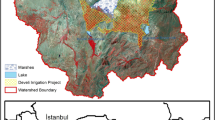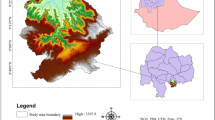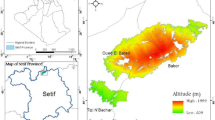Abstract
The objective of the current study is to use satellite data to assess the mutual influence between vegetation and climate. The Ismailia Governorate was selected as a case study to investigate the impact of vegetation cover expansion on both land surface and air temperature from 1983 to 2010 and vice versa. This observation site was carefully selected as a clear example of the high rate of the reclamation and vegetation expansion process in Egypt. Land surface temperature (LST) was estimated through the Advanced Very High Resolution Radiometer (a space-borne sensor embarked on the National Oceanic and Atmospheric Administration) data while air temperature (T air) was collected from ground meteorological stations in the study area. Irrigated agriculture is the largest consumer of freshwater resources. However, consistent information on irrigation water use is still lacking. Relative humidity, wind speed, solar radiation, and T air data were inserted in the Penman–Monteith equation to calculate potential evapotranspiration (ETo), while both LST and T air were used to observe the relative water status of the study area as a result of the water deficit index (WDI). Then, both WDI and ETo were used to calculate actual evepotranspiration (ETC.). The results showed that LST decreased by about 2.3 °C while T air decreased by about 1.6 °C during the study period. The results showed also that the vegetation cover expanded from 25,529.85 ha in 1985 to 63,140.49 ha in 2009 with about 147 % increase. This decrease in LST and air temperature was according to the expansion of the cultivated land that was proved through the processing of three Landsat TM and Landsat ETM+ imageries acquired in June 19, 1985, June 7, 1998, and June 29, 2009. The vegetation water consumption was affected by the decreasing surface and air temperature. The results showed that the water deficit index decreased by about 0.35, and actual evapotranspiration increased by about 2.5 mm during the study period.











Similar content being viewed by others
References
Allen RG, Perrier LS, Raes D, Smith M (1998) Crop evapotranspiration: guidelines for computing crop requirements. Irrigation and drainage paper no. 56. FAO, Rome
Clarke TR (1997) An empirical approach for detecting crop water stress using multispectral airborne sensors. Hort Technology 7(1):9–16
Comber AJ, Law ANR, Lishman JR (2004) A comparison of Bayes’, Dempster Shafter and endorsement theories for managing knowledge uncertainty in the context of land cover monitoring. Computers, Environment and Urban Systems 28(4):311–327
Dale VH (1997) The relationship between land-use change and climate change. Ecol Appl 7:753–769. doi:10.1890/1051-0761(1997)007[0753:TRBLUC]2.0.CO;2
Droogers P, Allen RG (2002) Estimating reference evapotranspiration under inaccurate data conditions. Irri Drain Syst 16(1):33–45
Fischer G, Tubiello FN, Velthuizen HV, Wiberg DV (2007) Climate change impacts on irrigation water requirements: effects of mitigation, 1990–2080. Tech Forec & Soc Change 74:1083–1107
Foody GM (2001) Monitoring the magnitude of land cover change around the southern limits of the Sahara. Photogramm Eng Rem Sens 67:841–847
Gao J, Liu YS, Chen YF (2006) Land cover changes during agrarian restructuring in Northeast China. Appl Geogr 26:312–322
Goyal RK (2004) Sensitivity of evapotranspiration to global warming: a case study of arid zone of Rajasthan. Agric Water Manag 69:1–11
Gusso A, Fontana DC (2005) Vertical variation survey of the actual air temperature using NOAA/AVHRR satellite data. anais xii simposio brasileiro de sensoriamento remoto, Goiana, Brasil, 173–179.
Hargreaves GL, Hargreaves GH, Riley JP (1985) Agricultural benefits for Senegal River Basin. J of Irri Drain Eng 111:111–124
Huete A, Didan K, Miura T, Rodriguez EP, Gao X, Ferreira LG (2002) Overview of the radiometric and biophysical performance of the MODIS vegetation indices. Remote Sens of Envi 83:195–213
Irmak S, Payero JO, Martin DL, Irmak A, Howell TA (2006) Sensitivity analyses and sensitivity coefficients of standardized daily ASCE-Penman–Monteith equation. J of Irri and Drain Engi 132:564–578
Jackson RD, Idso SB, Reginato RJ, Pinter PJ (1981) Canopy temperature as a crop water stress indicator. Water Resour Res 17:1133–1138
Lambin E, Ehrlich D (1997) Land cover changes in Africa, 1982–1991. Remote Sens Environ 61:181–200
Li ZL, Becker F (1993) Feasibility of land surface temperature and emissivity determination from AVHRR data. Remote Sens Environ 43:67–85
Loveland TR, Sohl TL, Stehman SV, Gallant AL, Sayler KL, Napton DE (2002) A strategy for estimating the rates of recent United States landcover changes. Photogramm Eng Remote Sens 68:1091–1099
Moran MS, Clarke TR, Inoue Y, Vidal A (1994) Estimating crop water deficit using the relation between surface air temperature and spectral vegetation index. Remote Sens Environ 46:246–263
Petit C, Scudder T, Lambin E (2001) Quantifying processes of land-cover change by remote sensing: resettlement and rapid land-cover changes in south-eastern Zambia. Int J Remote Sens 22(17):3435–3456
Pinheiro ACT, Mahoney R, Privette JL, Tucker CJ (2006) Development of a daily long term record of NOAA-14 AVHRR land surface temperature over Africa. Remote Sens Environ 103:153–164
Pitman AJ, Narisma GT, Pielke RA, Holbrook NJ (2004) Impact of land cover change on the climate of southwest Western Australia. J Geophys Res 109:D18109. doi:10.1029/2003JD004347
Popova Z, Kercheva M, Pereira LS (2005) Validation of the FAO methodology for computing ETo with limited data. In: ICID 21st European Regional Conference, Frankfurt/Slubice, p. 13.
Rana G, Katerji N (1998) A measurement based sensitivity analysis of the Penman-Monteith actual evapotranspiration model for crops of different height and in contrasting water status. Theor Appl Climatol 60:141–149
Rana G, Katerji N (2000) Measurement and estimation of actual evapotranspiration in the field under Mediterranean climate: a review. Eur J Agron 13:125–153
Rogan J, Miller J, Stow D, Franklin J, Levien L, Fischer C (2003) Land cover change mapping in California using classification trees with Landsat TM and ancillary data. Photogramm Eng Remote Sens 69:793–804
Saxton KE (1975) Sensitivity analyses of the combination evapotranspiration equation. Agric Meteor 15:343–353
Sobrino JA, Caselles V, Coll C (1993) Theoretical split-window algorithms for determining the actual surface temperature. Il Nuovo Cimento, Verona, 16C 3:219–236
Timbal B, Arblaster JM, Power SB (2006) Attribution of the late 20th century rainfall decline in South-West Australia. J of Climate 19:2046–2065
Valor E, Caselles V (1996) Mapping land surface emissivity from NDVI: application to European, African and South American areas. Remote Sens Environ 57:167–184
Wang D, Hejazi MI, Cai X, Valocchi A (2011) Climate change impact on meteorological, agricultural, and hydrological drought in Central Illinois. Water Resour Res. doi:10.1029/2010WR009845
Zhao M, Pitman AJ, Chase TN (2001) Climatic effects of land cover change at different carbon dioxide levels. Clim Res 17:1–18
Zhang J, Yang J (2004) Crop yield and water use efficiency: a study case in rice, In: Bacon MA (ed) Water use efficiency in plant biology. Blackwell, Australia, pp 198–227
Acknowledgments
We would like to thank NASA for data availability. We would like to thank NARSS and Ain Shams University (Egypt) for their support and encouragement. Thanks to everyone who participated in this study.
Author information
Authors and Affiliations
Corresponding authors
Rights and permissions
About this article
Cite this article
El-Shirbeny, M.A., Aboelghar, M.A., Arafat, S.M. et al. Assessment of the mutual impact between climate and vegetation cover using NOAA-AVHRR and Landsat data in Egypt. Arab J Geosci 7, 1287–1296 (2014). https://doi.org/10.1007/s12517-012-0791-3
Received:
Accepted:
Published:
Issue Date:
DOI: https://doi.org/10.1007/s12517-012-0791-3




